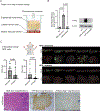ATAD2 Drives Prostate Cancer Progression to Metastasis
- PMID: 39907729
- PMCID: PMC12048280
- DOI: 10.1158/1541-7786.MCR-24-0544
ATAD2 Drives Prostate Cancer Progression to Metastasis
Abstract
Metastasis accounts for the overwhelming majority of cancer deaths. In prostate cancer and many other solid tumors, progression to metastasis is associated with drastically reduced survival outcomes, yet the mechanisms behind this progression remain largely unknown. ATPase family AAA domain containing 2 (ATAD2) is an epigenetic reader of acetylated histones that is overexpressed in multiple cancer types and usually associated with poor patient outcomes. However, the functional role of ATAD2 in cancer progression and metastasis has been relatively understudied. Here, we employ genetically engineered mouse models of prostate cancer bone metastasis, as well as multiple independent human cohorts, to show that ATAD2 is highly enriched in bone metastasis compared with primary tumors and significantly associated with the development of metastasis. We show that ATAD2 expression is associated with MYC pathway activation in patient datasets and that, at least in a subset of tumors, MYC and ATAD2 can regulate each other's expression. Using functional studies on mouse bone metastatic cell lines and innovative organ-on-a-chip bone invasion assays, we establish a functional role for ATAD2 inhibition in reducing prostate cancer metastasis and growth in bone. Implications: Our study highlights ATAD2 as a driver of prostate cancer progression and metastasis and suggests it may constitute a promising novel therapeutic target.
©2025 American Association for Cancer Research.
Conflict of interest statement
RJK: Prior research support & intellectual property licensed to Veracyte.
MA and ED: employees of Veracyte, Inc.
All other authors report no competing interests.
Figures




References
-
- Helgstrand JT, Roder MA, Klemann N, Toft BG, Lichtensztajn DY, Brooks JD, et al. Trends in incidence and 5-year mortality in men with newly diagnosed, metastatic prostate cancer-A population-based analysis of 2 national cohorts. Cancer. 2018;124(14):2931–8. Epub 20180503. doi: 10.1002/cncr.31384. - DOI - PubMed
MeSH terms
Substances
Grants and funding
- UL1TR001873/National Center for Advancing Translational Sciences (NCATS)
- P30CA196521/National Cancer Institute (NCI)
- K22 CA258806/CA/NCI NIH HHS/United States
- 1K22CA258806/National Cancer Institute (NCI)
- R01 CA173481/CA/NCI NIH HHS/United States
- S10 OD026880/OD/NIH HHS/United States
- P30 CA013696/CA/NCI NIH HHS/United States
- R01 CA193442/CA/NCI NIH HHS/United States
- P41 EB027062/EB/NIBIB NIH HHS/United States
- 20YOUN25/Prostate Cancer Foundation (PCF)
- P30 CA196521/CA/NCI NIH HHS/United States
- R01 CA183929/CA/NCI NIH HHS/United States
- W81XWH-15-1-0185/DOD Prostate Cancer Research Program (PCRP)
- UL1TR004419/National Center for Advancing Translational Sciences (NCATS)
- R01 CA249799/CA/NCI NIH HHS/United States
- W81XWH-18-2-0013/DOD Prostate Cancer Research Program (PCRP)
- UH3 EB025765/EB/NIBIB NIH HHS/United States
- P01 CA265768/CA/NCI NIH HHS/United States
- UL1 TR004419/TR/NCATS NIH HHS/United States
- Prostate Cancer Foundation (PCF)
- S10 OD030463/OD/NIH HHS/United States
- P30CA013696/National Cancer Institute (NCI)
- U54 CA274506/CA/NCI NIH HHS/United States
- UL1 TR001873/TR/NCATS NIH HHS/United States
LinkOut - more resources
Full Text Sources
Medical
Molecular Biology Databases

